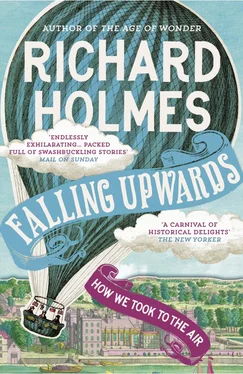RICHARD HOLMES
Falling Upwards
How We Took to the Air

To Eleanor Tremain and John Lightbody
with love and balloons
Contents
Title Page RICHARD HOLMES Falling Upwards How We Took to the Air
Dedication To Eleanor Tremain and John Lightbody with love and balloons
Voices Overhead
1. The Falling Dream
2. Fiery Prospects
3. Airy Kingdoms
4. Angel’s Eye
5. Wild West Wind
6. Spies in the Sky
7. Gigantic Voyages
8. Vertical Explorations
9. Mariners of the Upper Atmosphere
10. Paris Airborne
11. Extreme Balloons
Epilogue
Classic Balloon Accounts
Illustrations
Picture Section
Footnotes
References
Bibliography
Index
Acknowledgements
By the same author
Copyright
About the Publisher
‘A Cloud in a paper bag’
JOSEPH MONTGOLFIER, 1782
‘Someone asked me – what’s the use of a balloon?
I replied – what’s the use of a new-born baby ’
BENJAMIN FRANKLIN, 1783
‘Practical flying we may leave to our rivals the French.
Theoretical flying we may claim for ourselves’
SIR JOSEPH BANKS, 1784
‘I would make it death for a man to be convicted of flying, the moment he could be caught’
WILLIAM COWPER, 1794
‘O Thou who plumed with strong desire
Would float above the Earth – beware!
A shadow tracks thy flight of fire –
Night is coming!’
P.B. SHELLEY, 1818
‘There’s something in a flying horse,
There’s something in a huge balloon’
WILLIAM WORDSWORTH, 1819
‘No man can have a just estimation of the insignificance of his species, unless he has been up in an air-balloon’
BENJAMIN ROBERT HAYDON, 1825
‘Your balloon voyage so occupied my mind that I dreamt of it!’
J.M.W. TURNER, 1836
‘Beautiful invention, mounting heavenward – so beautifully, so unguidably! Emblem of our Age, of Hope itself’
THOMAS CARLYLE, 1837
‘How should I manage all my business if I were obliged to marry – I never should know French, or go to America, or go up in a Balloon’
CHARLES DARWIN, 1838
‘To look down upon the whole of London as the birds of the air look down upon it, and see it dwindled into a mere rubbish heap’
HENRY MAYHEW, 1852
‘Chance people on the bridges peering over the parapets, into a nether sky of fog, with fog all round them as if they were up in a balloon and hanging in misty clouds’
CHARLES DICKENS, 1852
‘The basket was about two feet high, four feet long … to me it seemed fragile indeed … the gaps in the wicker work in the sides and the bottom seemed immense and the further we receded from the earth, the larger they seemed to become’
GEORGE ARMSTRONG CUSTER, 1862
‘Poetry has described some famous descents into the subterranean world … But we have just had an ascent such as the world has never heard of or dreamed of’
THE TIMES , 1863
‘Next to the climbers of the Alpine Club, in order of utter uselessness are the people who go up in balloons, and who come down to tell us of the temperature, the air-currents, the shape of the clouds, and amount of atmospheric pressure in a region where nobody wants to go, nor has the slightest interest to hear about’
BLACKWOOD’S MAGAZINE , October 1864
‘Dear Nadar, I must beg you to renounce these terrible balloon- antics !’
GEORGE SAND, 1865
‘I am an Ancient Mariner of the Upper Atmosphere’
CHARLES GREEN, 1868
‘Paris is surrounded, blockaded, blotted out from the rest of the world! – and yet by means of a simple balloon, a mere bubble of air, Paris is back in communication with the rest of the world!’
VICTOR HUGO, 1870
‘It has already done for us that which no other power ever accomplished: it has gratified the desire natural to us all to view the earth in a new aspect’
JAMES GLAISHER, 1872
‘The spectacle was over by the time we gained the top of the hill. All the gold had withered out of the sky, and the balloon had disappeared’
ROBERT LOUIS STEVENSON, 1878
‘Is it not a little strange to be floating here above the Polar Sea?
To be the first that have floated here in a balloon! How soon, I wonder, shall we have successors? Shall we be thought mad or will our example be followed?’
SALOMON ANDRÉE, 1897
‘Between my boots and the now distant earth there was nothing.
I wriggled my feet and laughed. I was walking on air …
I really was walking on air!’
DOLLY SHEPHERD, 1904
‘To be alone in a balloon at a height of fourteen or fifteen thousand feet is like nothing else in human experience. It is one of the supreme things possible to man. No flying machine can ever better it.
It is to pass extraordinarily out of human things’
H.G. WELLS, 1908
‘The miracle is not to fly in the air, or to walk on the water, but to walk on the earth’
CHINESE PROVERB
My own falling dream began at a village fête in Norfolk. I was four years old. My uncle, a tall and usually silent RAF pilot, had bought a red party balloon from a charity stall, and tied it to the top button of my aertex shirt. This was my first balloon, and it seemed to have a mind of its own. It was inflated with helium, which is a gas fourteen times lighter than air, though I did not understand this at the time. It pulled mysteriously and insistently at my button. ‘Maybe you will fly,’ my uncle remarked. He led me up a grassy bank so we could look over the whole fête. Below me stretched the little tents, the stalls, the show ring with its bales of straw and small dancing horses. Above me bobbed the big red balloon, gleaming and beautiful, blotting out the sun. It bounced off the top of my head, making a strange springy sound, full of distance. It tugged me impatiently towards the sky, and I began to feel unsteady on my feet. I felt that I was falling – upwards. Then my uncle let go of my hand, and my dream began.
Throughout history, dreamlike stories and romantic adventures have always attached themselves to balloons. Some are factual, some are pure fantasy, many (the most interesting) are a provoking mixture of the two. But some kind of narrative basket always seems to come tantalisingly suspended beneath them. Show me a balloon and I’ll show you a story; quite often a tall one. And very frequently it is a story of courage in the face of imminent catastrophe.
What’s more, all balloon flights are naturally three-act dramas. The First Act is the launch: the human drama of plans, hopes, expectations. The Second Act is the flight itself: the realities, the visions, the possible discoveries. The Final Act is the landing, the least predictable, most perilous part of any ascent, which may bring triumph or disaster or (quite often) farce. The ultimate nature of any particular balloon ascent – a pastoral, a tragedy, a comedy, a melodrama, even a sitcom – is never clear until the balloon is safely back on earth. Sometimes it is not clear even then.
Even the well-known fable of the Cretan engineer Daedalus and his young son Icarus, so often retold as the Genesis myth of flying, is curiously ambiguous in its outcome. It appears originally in Book VIII of Ovid’s long poem Metamorphoses , ‘The Transformations’, completed two thousand years ago, around 8 AD. Having constructed wings for both of them, Daedalus and son launch into the empyrean together, but famously the impetuous Icarus flies too high; the wax joints of his feathered wings melt ‘in the scorching heat of the sun’, and he tumbles down into the sea. Yet this primal legend of flight is more complex than it might appear.
Читать дальше













